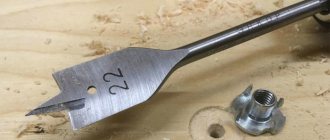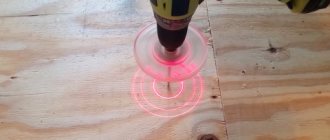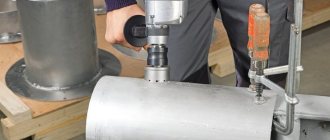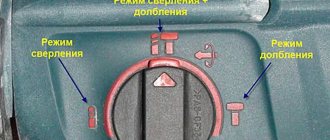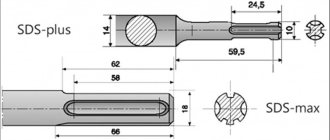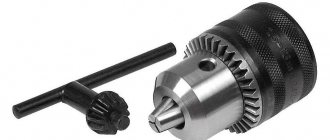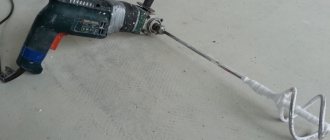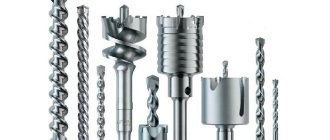Home craftsmen, who are accustomed to doing on their own some of the work necessary to maintain a cozy and comfortable environment in the house, are forced to solve many problems. Among them, drilling holes in materials with a strong structure is quite relevant.
These can be concrete, surfaces made of foam blocks, bricks, etc. And it is not possible to create holes in them using ordinary drills designed for working with metal and wood. All efforts at drilling soon lead to the fact that the tool used becomes dull and can no longer be used even for its intended purpose. For this reason, you have to think about purchasing appropriate concrete drills.
Drill design
The design of the drill is quite standard. It consists of standard components such as a shank, cutting elements and chip removal elements. Made from alloys of increased hardness, the tip resembles the letter T.
Such tips are used when working with hard materials (metals, concrete, marble). To avoid confusion, it is better to look at a photo of a concrete drill.
Some of the best concrete drills are Pobedit drills. Pobedit is a special alloy of tungsten and cobalt, but quite a long time ago this alloy ceased to be used due to its high cost and was replaced by cheaper and higher-quality analogues.
The pobedite drill is presented on the market in very large quantities, but the brand name of the drill itself is not indicated on the description, which means that you can select it yourself based on your experience or the knowledge of the seller.
If you see drills with strange Chinese symbols, it is better to avoid this purchase, since they will only last for a couple of minutes of work (at best).
There is one tradition, the essence of which is to wet the tip of the drill (or the entire drill bit) with water. Some argue that this procedure will preserve the drill and lead to better work without breakage. But as production researchers found out, cooling the drill does not affect its operation in any way.
Also, a Pobedit drill can be sharpened quite easily, but this must be done carefully - there is a risk of overheating the drill and breaking off part of it. This should be done when the drill becomes dull.
Correct selection of drills
The main criterion will be the choice of drill according to the chuck. Depending on the hammer drill chuck, the drill is also selected, because another type simply will not work.
After this, you need to choose the required size. When choosing a drill, choose a size that is slightly smaller than the required hole. This is due to the fact that when the hammer drill operates, an error is created, which crushes the concrete (and other elements) around the circumference as the drill moves. The assortment on the market is very large, so it will not be difficult to choose a smaller one.
The third thing you need to pay attention to is the length. It's a matter of the depth of the required hole, and the assortment allows you to find what you need.
But long drills with half a meter and a diameter the size of a match simply do not exist - as the length increases, small diameters are discarded and vice versa.
What do the symbols on the drills say?
22.06.2016
A drill is a cutting tool for making blind or through holes in a solid body of material, drilling out existing holes or recesses, as well as performing other types of work. The drill acts on the material only in the axial direction! (unlike cutters that can also work with longitudinal feed).
Structurally, the drill consists of a front cutting cone (with sharp working edges), outlet spiral grooves and a shank for mounting a drilling tool - a drill, a machine tool, a hammer drill - in a chuck. Depending on the purpose, all three elements of the drill can have different shapes and designs. To an experienced craftsman, they can tell no less about the purpose and “character” of the drill than the brand markings!
Drills by type
Depending on the “reference point”, all drills can be divided into several large groups:
- by type of tool material (high-speed steel, pobedite, hardened, with a protective coating, etc.);
- for metal work;
- for wood (characterized by the presence of a thin, sharp tip for ease of initial cutting into the material);
- for fragile but hard materials (concrete, brick, etc.) - recognizable by a characteristic cutting cone with a pair of “petals” having hard surfacing;
- for drilling with shock loading - they are distinguished by protrusions and grooves on the cylindrical shank for mounting in a hammer drill chuck.
Thus, even before looking at the markings of the drill, you can accurately determine the type and purpose of the tool by external signs. And only then move on to a detailed consideration of its characteristics.
Drill marking
Very thin drills usually do not have any markings (there is simply nowhere to engrave them!). On the shanks of drills with a diameter of 3 mm or more, an alphanumeric code is applied, indicating:
- grade of material - the most common high-speed steel is designated by the letter P. Tungsten-free high-speed steels (grades EK-41, EK-42) and hard alloys (VK6, VK8, T15K6, T5K10) are also used;
- percentage of tungsten in the alloy (for example P6 - high-speed steel with 6% tungsten);
- types of alloying elements (letters: M denotes molybdenum, F – vanadium, K – cobalt, A – nitrogen, Ш – electroslag remelting);
- mass fractions of other alloying elements (also in numbers);
- Finally, the diameter symbol (may be missing) and the number next to it indicate the working size of the drill.
For example: the marking on the drill “R6M5K5 10.6” is a tool high-speed steel with 6% tungsten in the alloy, plus alloying additives of molybdenum (5%) and cobalt (5%), tool diameter 10.6 mm.
It should be noted that the larger the drill diameter, the more detailed the markings on it (may include accuracy class, manufacturer’s name, etc.).
Marking of the feather cutting tool
Strength is indicated:
- P18 is a satisfactory indicator, increased grindability, indicating a wide range of quenching temperatures.
- P 9 – characterized by increased wear resistance, a narrower range of hardening temperature indicators, and increased ductility.
- P6M5 – molybdenum is additionally added, increasing the tendency to decarbonization.
- R12F3 – have reduced grindability, used for drilling in medium mode. Added 3% vanadium.
- R6M5F3 – increased wear resistance, work at medium cutting speed, used for carbon and alloy tool steels.
- R9K5,
- R6M5K5,
- R18K5F2 – cobalt is added, which provides increased secondary hardness, heat resistance, and increased cutting conditions.
They have the designation 2304 - operational and design characteristics. Full marking 2304-4001-50-108. The indicator from 50 to 108 may vary. It indicates the possible diameter value.
Foreign markings (DIN and HSS) are deciphered a little differently - although they mean basically the same thing.
- HSS (High Speed Steel) – general marking of a group of high-speed steels;
- the following letters indicate the “specialization” of the drill: R (or without a letter designation) – drills with the lowest resistance, G – for working on carbon and alloy steels, cast iron and non-ferrous metals, E – for acid-resistant stainless steels, HSS-G TiN and HSS -G TiAlN – for processing titanium. Of course, “backward compatibility” is also true - a drill for titanium is perfect for processing both carbon and stainless steels;
- If desired, you can find out the detailed composition of the drill material using a special table.
Table of correspondence between the general chemical composition of HSS steels and their domestic analogues.
Type Domestic analog Chemical composition, %C (carbon) Mn (manganese) Si (silicon) Cr (chromium) V (vanadium) W (tungsten) Mo (molybdenum) Co (cobalt) Ni (nickel) Tungsten HSS steelsHigh alloy HSS steels
| T1 | P18 | 0,75 | — | — | 4,00 | 1,00 | 18,00 | — | — | — |
| T2 | R18F2 | 0,80 | — | — | 4,00 | 2,00 | 18,00 | — | — | — |
| T4 | R18K5F2 | 0,75 | — | — | 4,00 | 1,00 | 18,00 | — | 5,00 | — |
| T5 | 0,80 | — | — | 4,00 | 2,00 | 18,00 | — | 8,00 | — | |
| T6 | 0,80 | — | — | 4,50 | 1,50 | 20,00 | — | 12 | — | |
| T8 | 0,75 | — | — | 4,00 | 2,00 | 14,00 | — | 5,00 | — | |
| T15 | R12F5K5 | 1,50 | — | — | 4,00 | 5,00 | 12,00 | — | 5,00 | — |
| M41 | R6M3K5F2 | 1,10 | — | — | 4,25 | 2,00 | 6,75 | 3,75 | 5,00 | — |
| M42 | 1,10 | — | — | 3,75 | 1,15 | 1,50 | 9,50 | 8,00 | — | |
| M43 | 1,20 | — | — | 3,75 | 1,60 | 2,75 | 8,00 | 8,25 | — | |
| M44 | 1,15 | — | — | 4,25 | 2,00 | 5,25 | 6,25 | 12,00 | — | |
| M46 | 1,25 | — | — | 4,00 | 3,20 | 2,00 | 8,25 | 8,25 | — | |
| M47 | R2AM9K5 | 1,10 | — | — | 3,75 | 1,25 | 1,50 | 9,50 | 5,00 | — |
| M48 | 1,42-1,52 | 0,15-0,40 | 0,15-0,40 | 3,50-4,00 | 2,75-3,25 | 9,50-10,5 | 0,15-0,40 | 8,00-10,0 | up to 0.30 | |
| M50 | 0,78-0,88 | 0,15-0,45 | 0,20-0,60 | 3,75-4,50 | 0,80-1,25 | up to 0.10 | 3,90-4,75 | — | up to 0.30 | |
| M52 | 0,85-0,95 | 0,15-0,45 | 0,20-0,60 | 3,50-4,30 | 1,65-2,25 | 0,75-1,50 | 4,00-4,90 | — | up to 0.30 | |
| M62 | 1,25-1,35 | 0,15-0,40 | 0,15-0,40 | 3,50-4,00 | 1,80-2,00 | 5,75-6,50 | 10,0-11,0 | — | up to 0.30 |
For example, drills marked M1 are more flexible and less susceptible to shock, and are suitable for general work. M2 drills are already used for high-performance machine work, due to the high degree of red resistance and preservation of the cutting edge. The M7 marking indicates flexibility and increased drill life, which is important when drilling hard sheet metal. Drills are made from M42 steel for work on tough and complex materials, and drills are made from M50 steel for portable equipment, where tool breakage due to bending is undesirable.
HSS-E drills are analogues of the domestic universal P6M5. They are suitable for working on both low-carbon steels and cast iron, as well as hard alloy and stainless steels (including acid-resistant).
And the HSS-Co tool (with the addition of cobalt to the alloy) is similar to the Russian R6M5K5 drill (also containing 5% cobalt in the high-speed alloy). HSS-G TiN is the most durable drill for working with durable titanium products.
Its analogue is the domestic tool R6T5 (the last letter and number indicate a 5% titanium content, which gives high-speed steel special strength).
The surface hardness of a drill with a titanium-aluminum-nitride coating (HSS-G TiAlN) is already 3000 HV, and the heat resistance is 900°C. Finally, drills for stainless steel are marked HSS-E VAP (V2A or V4A).
Drill bits for rotary hammers
Hammer drills are often called “drills.” They have a number of characteristic differences:
- firstly, almost only fragile but very hard materials (concrete, brick, natural stone, etc.) are processed with impact loading. For this purpose, the drills have a special, reinforced design and super-hard surfacing on the cutting edges (the cutting tip with petal edges of the drills is similar in design to that of concrete drills).
- and secondly, the drills are installed in special drilling machines - rotary hammers. Their cartridges perform not only rotational, but also axial movement. This achieves the impact of the tool on the material - along with a rotational “biting” into it. Such mechanics require strong fastening of the tool in the hammer drill chuck - for this purpose, drills have a shank with longitudinal projections and grooves (unlike conventional drills with absolutely smooth cylindrical shanks). This drill fastening system is called SDS.
In accordance with this, the markings on drills are somewhat different from those for conventional drills:
- the first is the letter designation of the drill fastening system (shank design) - SDS-max or SDS-plus;
- then two numbers indicate the diameter and length of the drill (in millimeters).
For example, the “SDS-max 16*670” drill has a diameter of 16 mm and a working part length of 670 mm.
It should be noted that the diameter of the drill is always equal to an even number. Accordingly, the size range of tools will look like Ø4 mm, Ø6 mm, Ø8 mm, etc.
And back to the appearance!
At the beginning of the article, we talked about the appearance of the drill - to an experienced eye, its structural shape will immediately allow you to determine its purpose. Equally valuable information can be gleaned by assessing the color of a drill or auger:
- regular gray indicates bare, uncoated tool steel. Such a tool may be of high quality, but it is susceptible to corrosion and rapid wear (since it does not have additional heat treatment that strengthens the steel);
- A “bold” black tint indicates that the material has been treated with steam. This increases the durability of the tool, increasing its service life;
- a yellow-golden color means that the drill material was subjected to hardening (significantly increasing the strength of the tool) and then tempering (heat treatment to relieve internal stresses after hardening). Such drills have good durability, but due to the tendency of hardened steel to develop brittle cracks, the “golden” tool is sensitive to overheating and temperature changes. Therefore, during work, it is necessary to periodically cool the tool, adhering to the manufacturer’s recommendations (this is especially true for drills for rotary hammers). And under no circumstances should drills be cooled with liquid!
- bright golden color - the surface of such a drill is treated with titanium nitride. This coating reduces contact friction in the cutting area while simultaneously strengthening the metal of the tool.
It is “golden” drills and augers that are considered the “elite” among quality tools. But the price of such drills is naturally higher.
The materials were prepared by specialists. When copying texts and other materials from the site, it is mandatory to provide a link to the site www.traiv-komplekt.ru!

